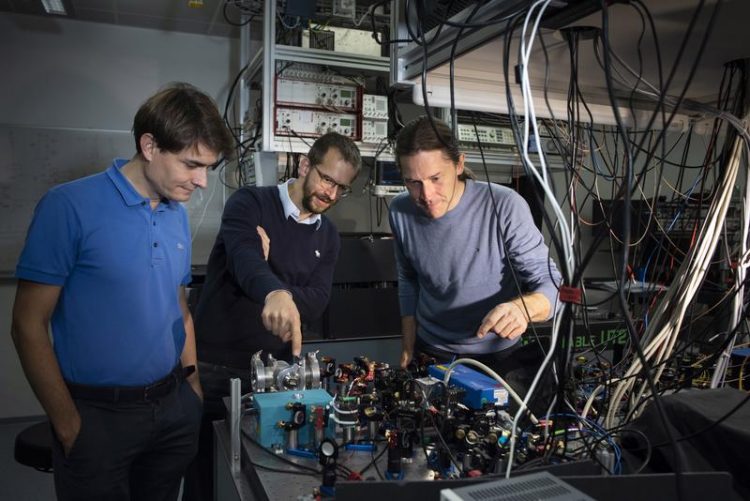Quantum Technologies Flagship: Basel physicists participate in three research consortia

On board the quantum flagship: the three Basel physicists Prof. Nicolas Sangouard, Prof. Patrick Maletinsky and Prof. Philipp Treutlein (left to right). Photo: University of Basel, Christian Flierl
Quantum physics describes the behavior of matter at a microscopic level and forms the basis for the great technological revolutions of the last few decades. Without an understanding of quantum physics, computer and communications technology, laser and medical imaging techniques would never have been developed.
Until now, however, these technologies have not yet exploited the full potential of quantum physics, which allows for radically new phenomena: particles can be in a superposition of several states at the same time, or two distant, “entangled” particles can form such a strong unit that their properties are no longer independent of each other.
On the way to the second quantum revolution
In recent years, physicists have been able to show how they can not only observe these astonishing phenomena but also specifically control them and use them for completely new kinds of technology. These second-generation quantum technologies promise extremely powerful computers, secure communications, quantum simulators for basic research and pharmaceutics, and highly accurate sensors for use in materials science, navigation and medical technology.
Switzerland and other European countries are leading the way in university research on quantum technology. To also be at the forefront of the technology transfer to industry, the European Union has launched the Quantum Technology Flagship, a 1 billion euro funding program over a 10-year period that will give European quantum technology the decisive push towards becoming a market leader. About 140 international consortia of university research groups and industry partners applied for the first three-year funding period, of which only 20 were successful.
Success for Basel quantum physics
Researchers at the University of Basel are heavily involved in three consortia in the area of quantum optics and quantum sensing:
The MACQSIMAL project, co-founded by Professor Philipp Treutlein, is developing quantum sensors based on miniaturized atomic vapor cells. This will enable the realization of compact atomic clocks, gyroscopes, magnetic field sensors, imaging methods for microwave and terahertz fields, and gas detectors.
The technology has application potential in areas such as autonomous navigation, non-invasive medical diagnosis and drug detection. The project is firmly anchored in north-western Switzerland; it is coordinated by the research and technology organization CSEM with centers in Neuchâtel and Muttenz, who closely collaborate with the University of Basel.
The ASTERIQS consortium, which the Basel research group led by Patrick Maletinsky helped to initiate, also deals with sensors. The research alliance looks at the quantum properties of ultra-pure diamonds, which are used as precise measurement systems for quantum sensors.
They can be used to perform high-resolution measurements of magnetic and electric fields or temperatures, all of which the Basel researchers are pursuing, with a focus on applications on the nanometer scale. The innovative technologies will find applications in a broad range of semiconductor electronics, from basic research to medical diagnostics. The Basel spin-off Qnami is also an associate partner of the project, and will focus on the commercial exploitation of its results.
The Quantum Internet Alliance (QIA) project aims to develop a quantum internet that can be used to network quantum computers to powerful clusters, and for secure communication over large distances. The theoretical physicist Professor Nicolas Sangouard is involved in this project. He has already proposed numerous concepts for the realization of quantum networks, in which individual photons transfer information between network nodes.
Result of a long-term strategy
The physicists’ success is the result of a long-term strategy. “For years now, the University of Basel has built a research focus in the area of quantum technologies, which has an excellent international reputation,” explains Treutlein, who is also the Dean of Research in the Faculty of Science. “This is also reflected in the successful acquisition of prestigious externally funded research projects, such as the Quantum Technologies Flagship.” The participating researchers, who belong to the Department of Physics and the Swiss Nanoscience Institute (SNI), are highly motivated to put their research findings into practice.
Prof. Dr. Philipp Treutlein, University of Basel, Department of Physics, Tel. +41 61 207 37 66, email: philipp.treutlein@unibas.ch
Media Contact
More Information:
http://www.unibas.chAll latest news from the category: Physics and Astronomy
This area deals with the fundamental laws and building blocks of nature and how they interact, the properties and the behavior of matter, and research into space and time and their structures.
innovations-report provides in-depth reports and articles on subjects such as astrophysics, laser technologies, nuclear, quantum, particle and solid-state physics, nanotechnologies, planetary research and findings (Mars, Venus) and developments related to the Hubble Telescope.
Newest articles

A ‘language’ for ML models to predict nanopore properties
A large number of 2D materials like graphene can have nanopores – small holes formed by missing atoms through which foreign substances can pass. The properties of these nanopores dictate many…

Clinically validated, wearable ultrasound patch
… for continuous blood pressure monitoring. A team of researchers at the University of California San Diego has developed a new and improved wearable ultrasound patch for continuous and noninvasive…

A new puzzle piece for string theory research
Dr. Ksenia Fedosova from the Cluster of Excellence Mathematics Münster, along with an international research team, has proven a conjecture in string theory that physicists had proposed regarding certain equations….



